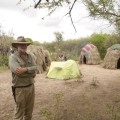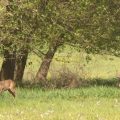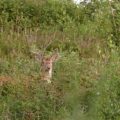(In English this time for our readers abroad)
It has been four years since we were in the Erongos, Namibia.
The Erongo Mountains are fantastic: it is a million year old vulcano. Huge boulders lie everywhere. If you look closely, you might find rock paintings, made by Bushmen, unknown how long ago that was. Just like in the caves in France, there are a lot of wild animals painted on them, well detailed and realistic. Among them is rhino as well.


Our basecamp is set at the foot of a mountain, called ‘the 3 elephants’ and indeed, they look like elephants too! On our way to this campsite, Werner (our guide) already spotted rhino tracks in the sand. We had a look at them before we erased everything with our car.


The next day we found the same tracks again. But fresh this time, so we decided to follow them. Trailing a black rhino!
A male black rhino can weigh up from 750 to a 1000 kilos! So with that in mind, plus all the loose sand, you might think trailing a black rhino is as easy as you can think of. Nothing like that.
In the pictures below you can see what it is like. A clear track on the left. But most of the tracks we found were like the right picture. Just the sand itself is flattened and only one ‘nail’ can clearly be seen.
Because of their soft padded feet, they are not easy to trail at all! You really have to look closely. It takes a while before you get used to the shape and what to look for. It is not a clear-to-see imprint as with ungulates. Antelopes leave very clear prints with their sharp hooves. A rhino ‘just’ flattens the substrate (picture right). On the left picture there is tracks of a dungbeetle (huge!) and a steenbok.
While trailing, the story evolves. We found the spot where he ate from a bush. Where he scraped the sand to mark his territory. And, hard to miss, found some of his droppings. They look-a-like elephant droppings, but here most of it was shattered, done by the rhino himself. And very interesting are it’s contents: little twig-particles which are all cut off in a 45 degree angle. As if he has been cutting with pruning shears!


After a while our rhino left a run in sand and changed to a more grassy area. Again you have to adapt to this new environment. Flattened grass looks different if you know what to look for. Slowly we move on, looking for clues, trying to think like this rhino:”what are your options, what route would you take?”
In the picture on the right you can see the animal turning left, instead of taking the ‘footpath/run’ straight ahead.


After a while we get the best evidence that we are on a fresh track. You must know that millipedes are BIG in Africa. At one moment we find such a millipede, it is still alive, but not going anywhere. Half of it’s body is out-of-function. Our rhino has stepped on it and disabled the millipede. This trail we are on is fresh!! Somewhere in front of us, is a rhino. We try and scan the bushes ahead of us…


With a large group of people (so: making quite some noise all together) and the wind coming exactly from the wrong direction (from behind, blowing all our smells and sounds towards the rhino ahead of us), we decide to quit trailing and leave the scene. Rhinos can be very grumpy and are not in for discussions. They can charge when they feel like.
So we turn around and leave the animal in peace.
What a great trailing adventure that was!
On the picture on the left you can see what is called a ‘T-stop’ ; where the animal stopped, and paused.
Rhinos have sadly become endangered species. Throughout Namibia we saw posters about the ongoing poaching. They are killed for their horns. These should contain some afrodisiac and are highly priced in China. It is very hard to stop these poachers. One of the methods is to spread the rhinos and make it harder for poachers to find and kill them. The sad thing is that a removed horn will regrow again! But poachers don’t mind, they kill an entire animal just for a pair of horns…
The Erongos are one of the areas where rhinos are reintroduced because of this government ‘tactics’. They seem to do well and no poaching is reported so far. Last year a rhino was found dead (with horns and all) so they think it might have been killed by a male rival. We had a chance to look at the skull and the pads of his feet.



















